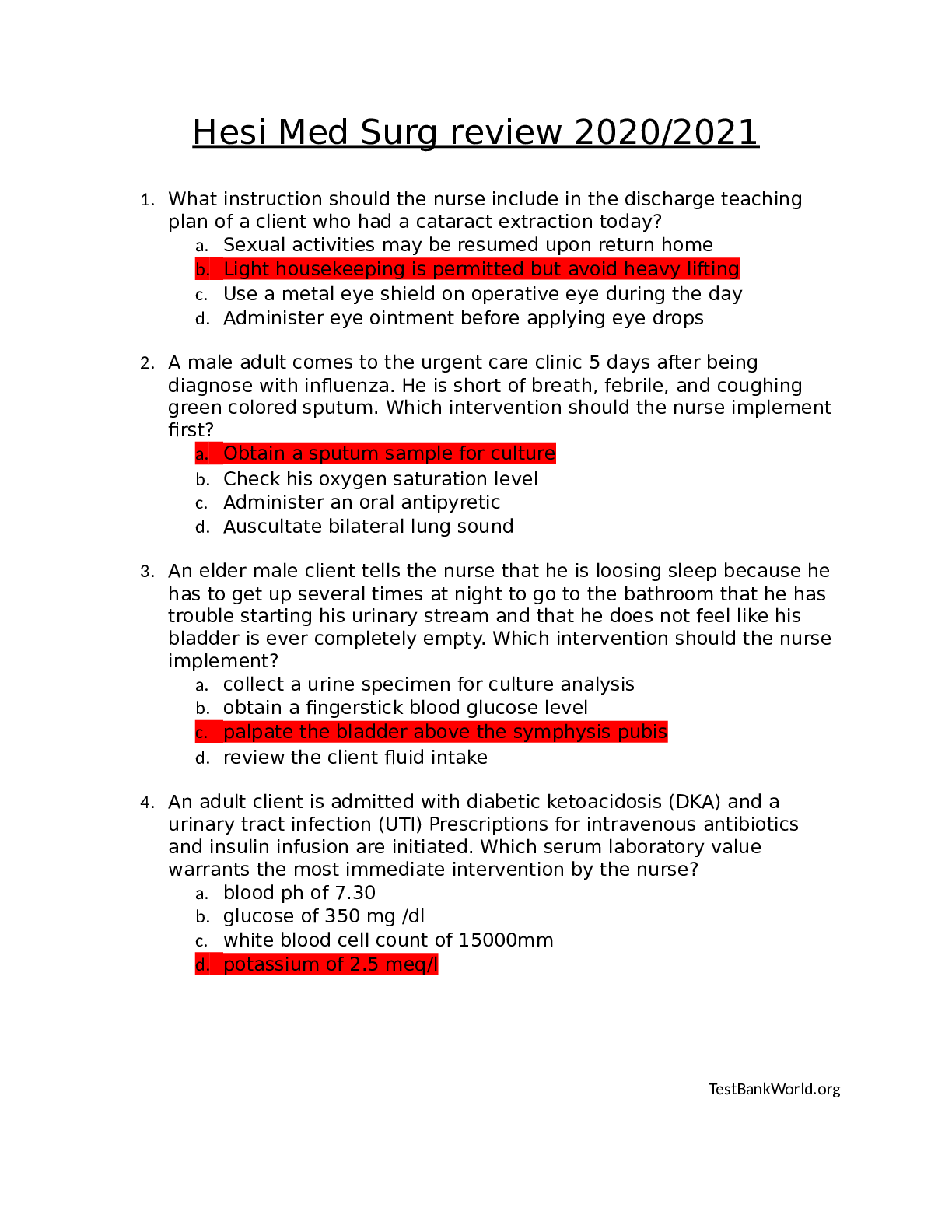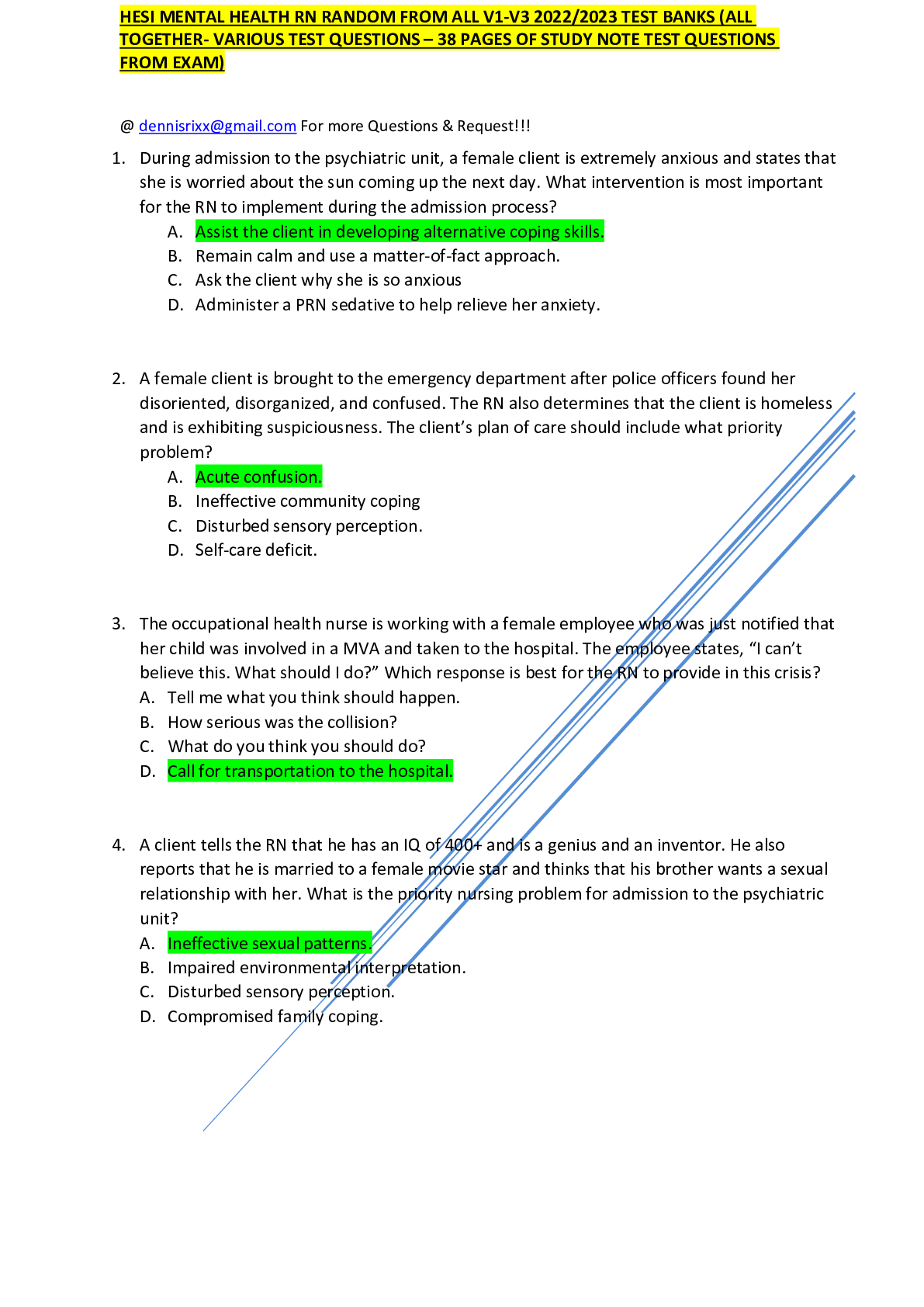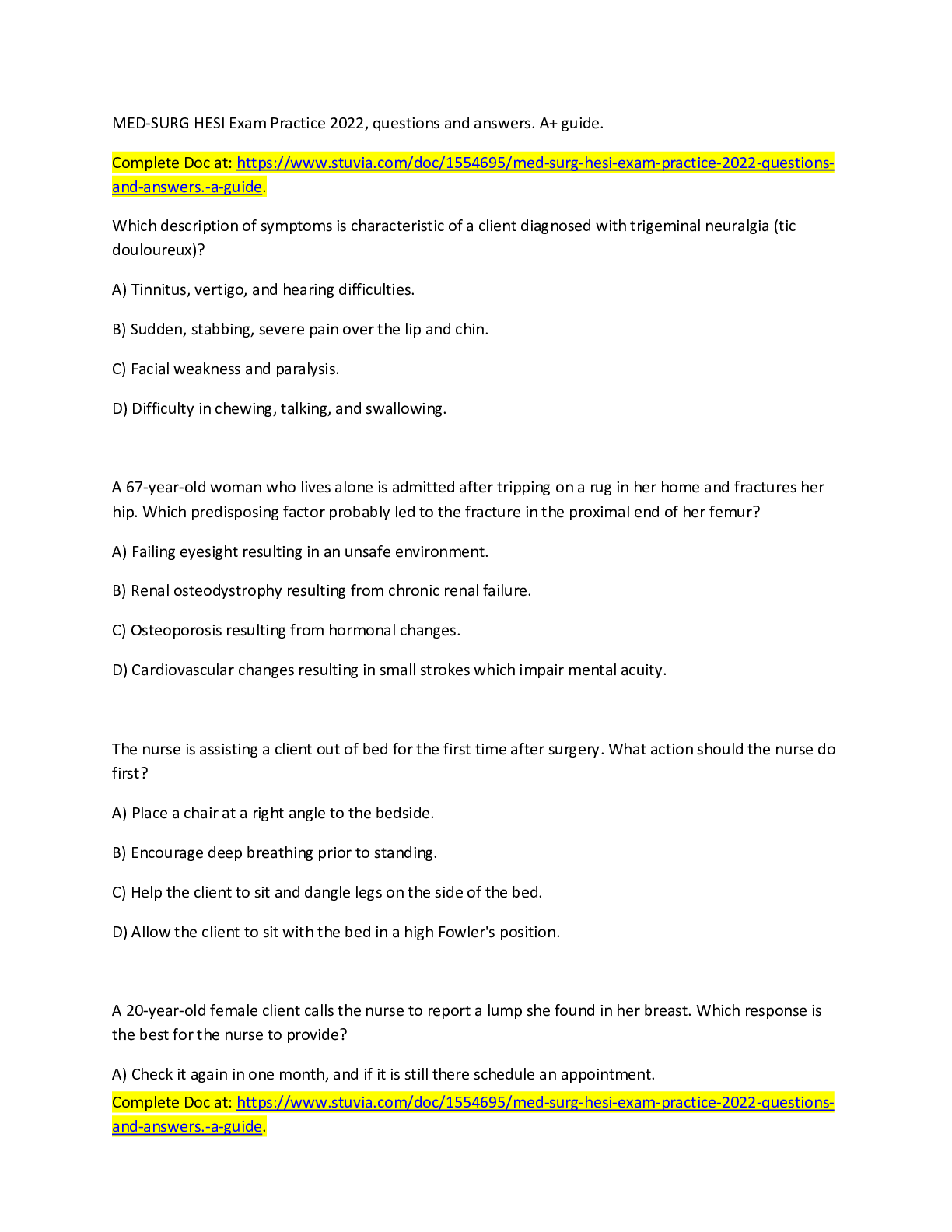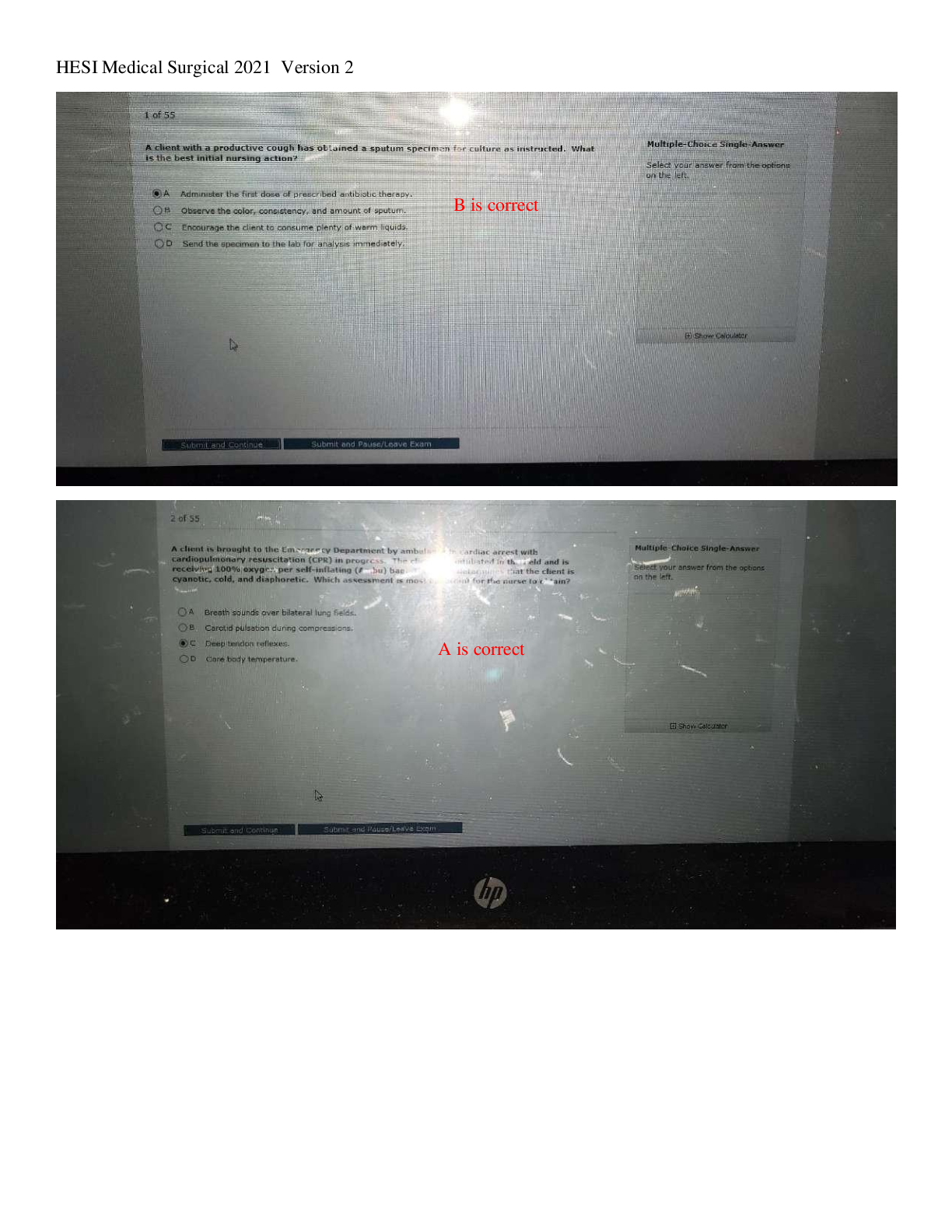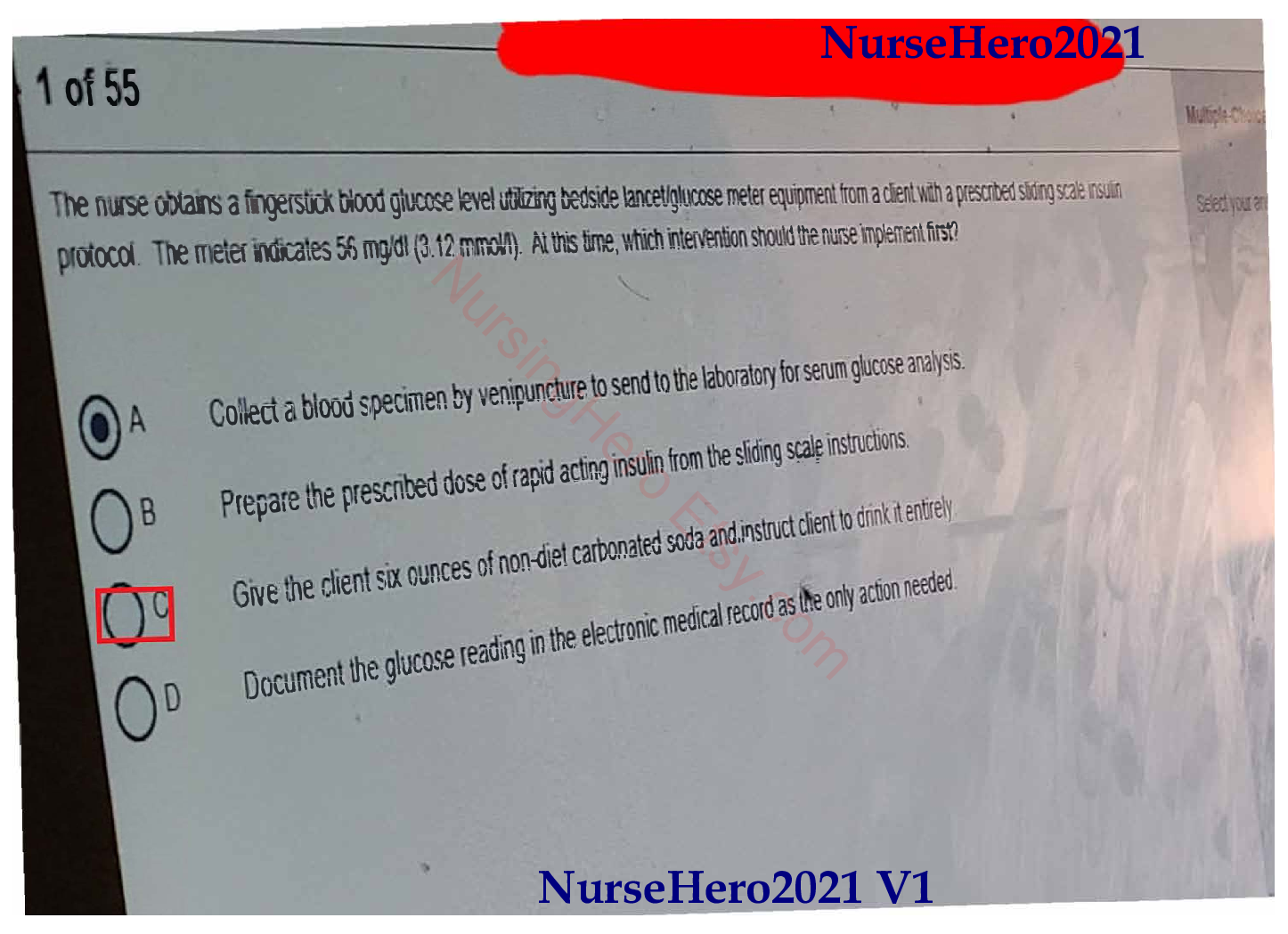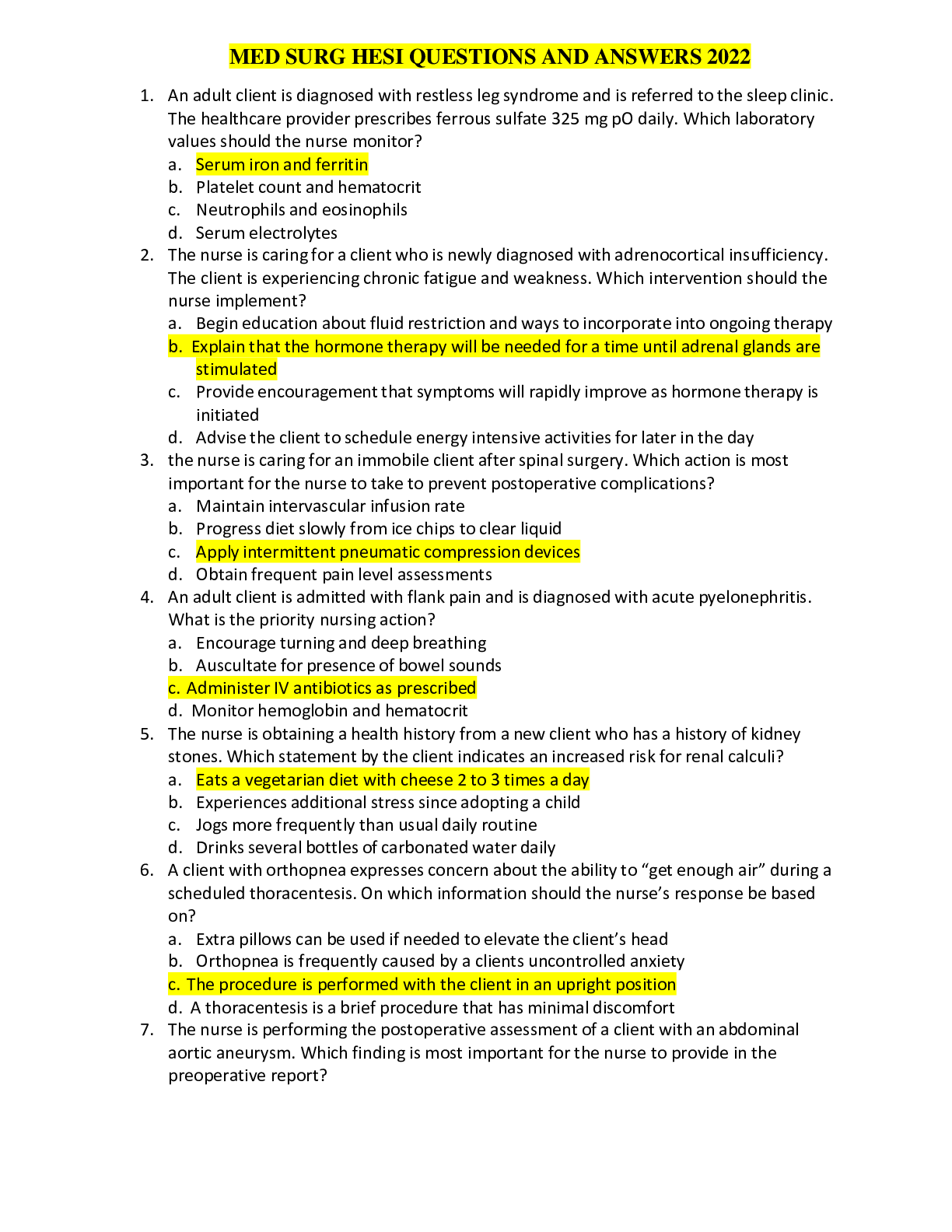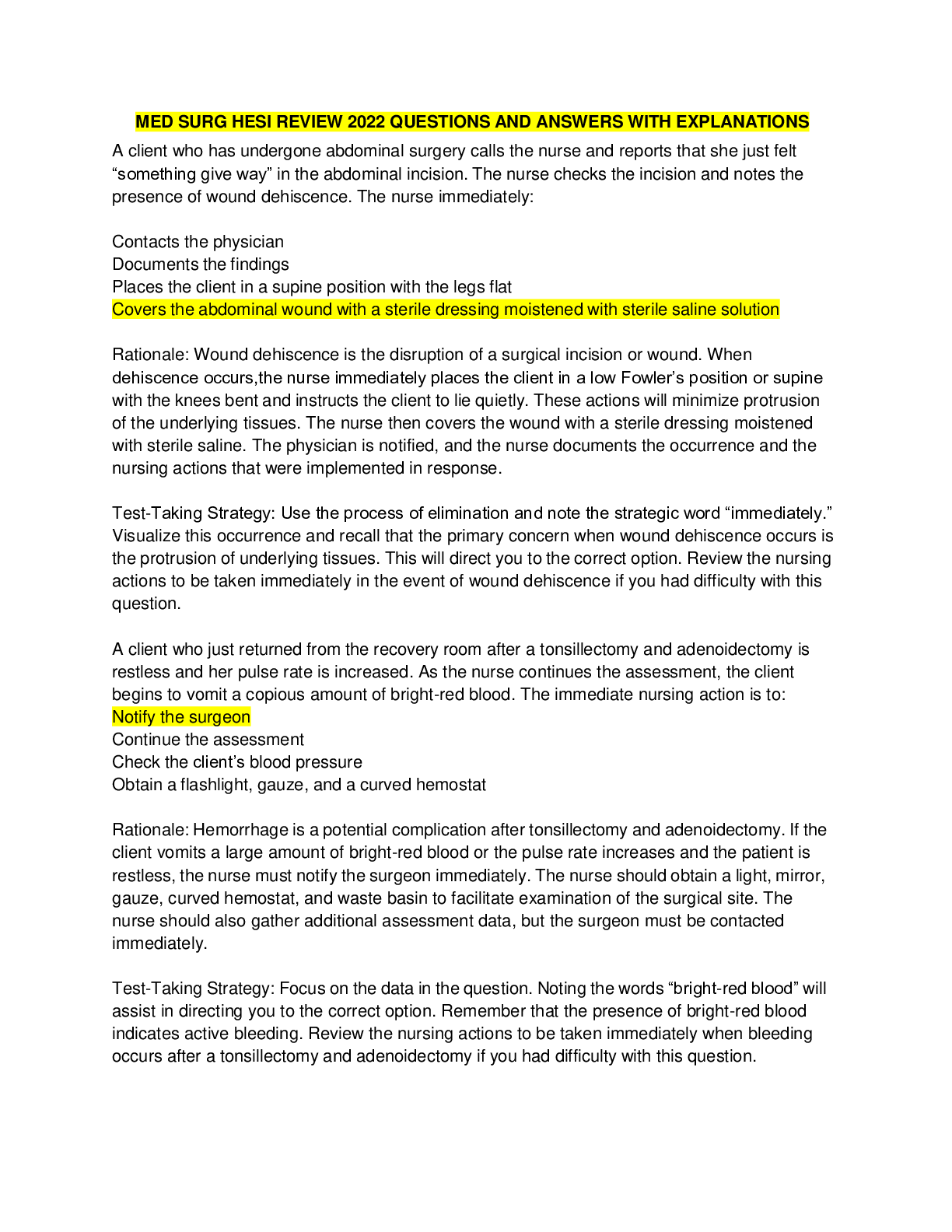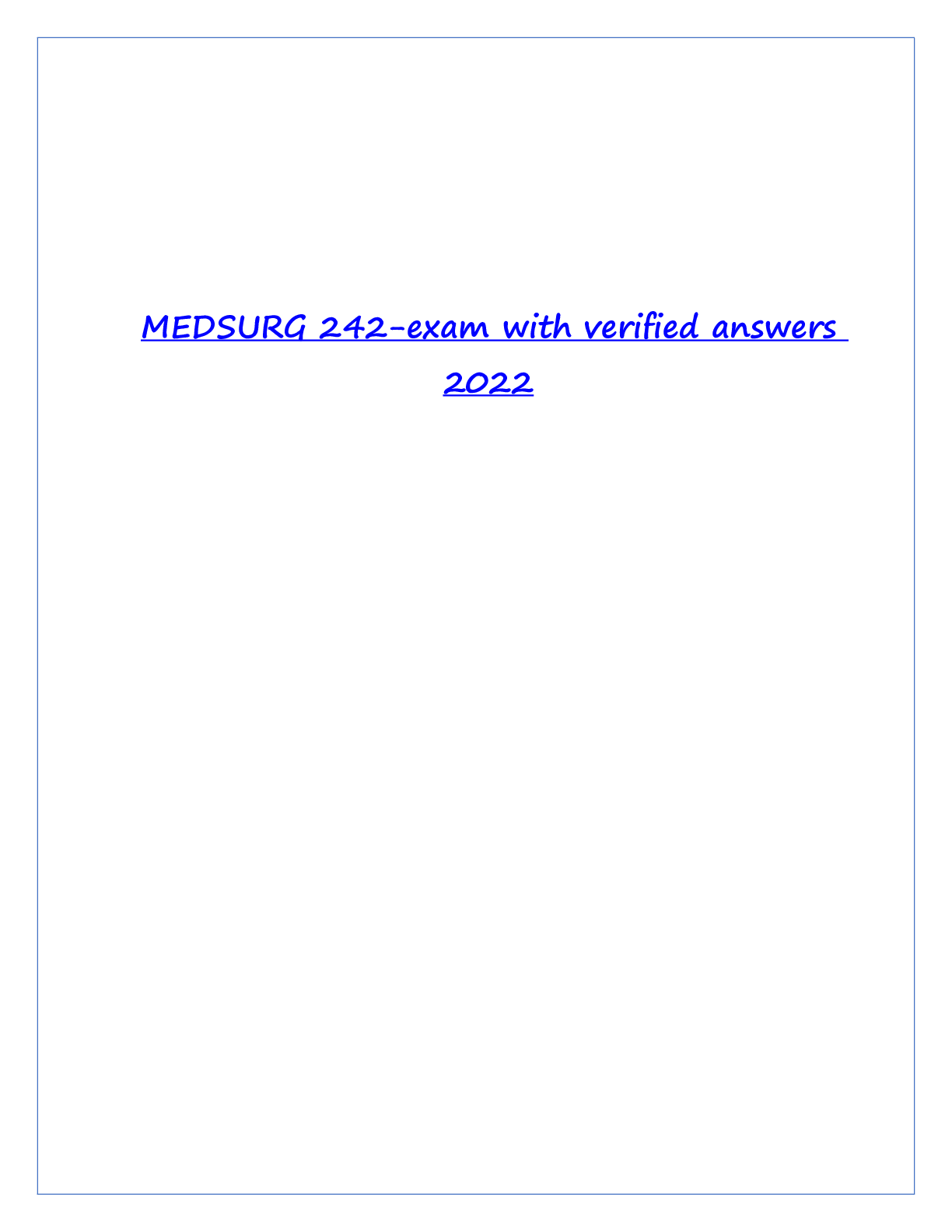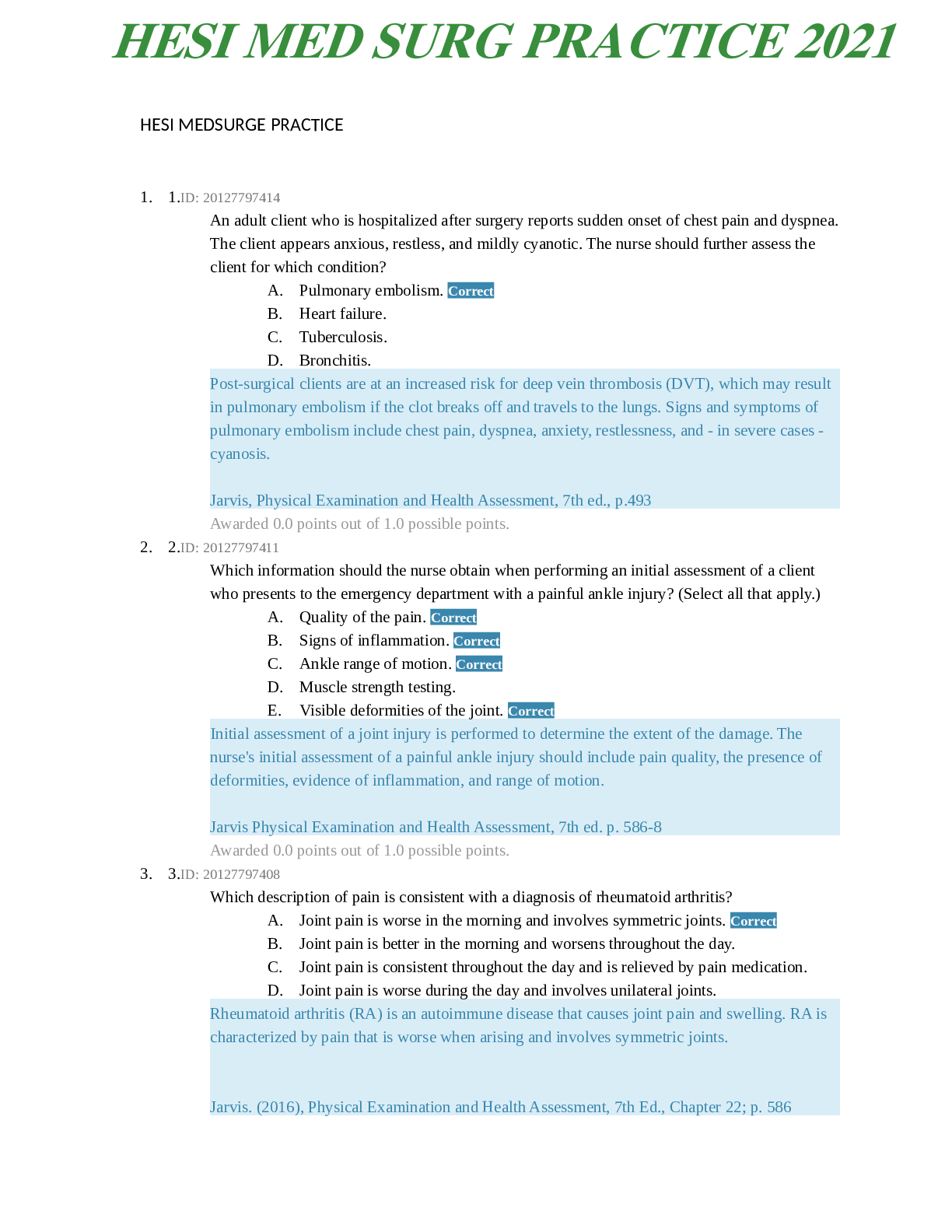*NURSING > HESI MED SURG > Pediatrics HESI PN Review Exam Questions and Answers with Rationale 100% CORRECT LATEST / RATED A+ (All)
Pediatrics HESI PN Review Exam Questions and Answers with Rationale 100% CORRECT LATEST / RATED A+
Document Content and Description Below
1.A toddler with a chronic illness that requires frequent hospitalization is likely to experience which psychosocial developmental problem? a) interference with the development of autonomy b) dist... ortion of differentiation of self from parent c) delayed language, fine motor, and self care skill d) fixation with the feelings of inadequacy 2.After reinforcing information to treat a sprained ankle, what statement by the adolescent indicates tot he PN that further instruction is needed? a) keep the leg elevated when sitting b) put an ice pack on the ankle, alternating 30 minutes on & 30 minutes off c) apply warm compresses to the ankle for the first 24 hours d) wrap the ankle in an elastic bandage for support 3.Which response should the PN provide a school age child who asks to talk with a dying sister? a) touch provides tactile presence of others if she does not responds to words b) talk loudly to ensure the dying client hears & recognizes others voices c) sitting close offers the dying person the sensation of others presence d) although the dying client may not response, she cna still hear what is said 4.The practical nurse (PN) is monitoring a child who is manifesting signs of shock after a motor vehicle collision. Which finding is most important for the PN to report to the charge nurse? a) narrowing pulse pressure b) apprehension c) irritability d) thirst 5.The mother of a 9 month old male infant is concerned because he cries whenever she leaves him with a sitter. What is the best response for the practical nurse (PN) to provide? a) "Have you noticed whether your baby is teething?" b) "Crying when you leave him in a healthy sign of attachment." c) "Consider taking the baby to the doctor because he may be ill." d) "You could consider leaving the infant more often so he can adjust." 6.Which preoperative action is most important for the practical nurse (PN) to implement for a newborn with meningomyelocele? a) document vital signs b) prevent skin breakdown c) minimize the risk for infection d) monitor neurologic functioning 7.The practical nurse is caring for a 6 year old girl who had surgery 12 hours ago. The child tells the PN that she does not have pain but a few minutes later, tells her parents that she does. What child development concept is relevant to this situation? a) inconsistency in pain reporting suggests that pain not present b) a child may have pain yet deny its presence to the nurse c) truthful reporting of pain should occur by this age d) children use pain experiences to manipulate their parents 8.A 6 year old who had a tonsillectomy 12 hours ago is complaining of thirst. What should the practical nurse (PN) offer? a) popsicle b) lemonade c) orange juice d) chocolate milk 9.The mother of a male newborn calls the clinic to inquire about the formation of a yellow crust over her son's circumcision area. What information should the practical nurse (PN) provide? a) do not remove the yellow crust from the site b) stop using petroleum around the head of the penis c) bring him into the clinic d) tightly fasten the diaper 10.The mother of a child with croup is having barking, coughing episodes calls the clinic for assistance. What action should the practical nurse (PN) recommend that the mother implement first? a) take the child outside in the cool air b) bring the child directly to the emergency room c) sit with the child in bathroom with a hot shower running d) have the child drink plenty of fluids 11.Which finding should the practical nurse confirm with the parents of an infant who is admitted with possible intussusception? a) red currant jelly stools b) clay colored stools c) constant abdominal pain d) projectile vomiting after meals 12.The practical nurse (PN) is observing a group of children at a day care center to determine whether children are achieving developmental milestones. Which activity should the PN identify as typical for a 2 year old child's cognitive development? a) has a vocabulary of about 1000 words b) uses short sentences to express self c) initiates play with other children d) recognizes right and wrong 13.The practical nurse (PN) is interviewing a 10 year old girl about school and her extracurricular activities. She responds, "I like school. I play the flute in the school band, and I take tennis lessons." Based on Erikson's psychosocial theory, the PN identifies that this child is in what stage of development? a) identity b) intimacy c) industry d) initiative 14.The practical nurse (PN) identifies an increased frequency of otitis media (OM) is children who are coming to the clinic. Based on this finding, which age group should the PN monitor a child for signs and symptoms of OM? a) toddler b) preschooler c) school ager d) adolescent 15.The practical nurse (PN) collects information about infant growth and development milestones for infants who come to the clinic for a well child visit. Which findings should the PN document as normal infant growth and development? a) maternal iron stores persist during the first 12 months of life b) anterior fontanel closes by 6 to 10 months of age c) binocularity is well established by 8 months of age d) birth weight double by age 5 months and triples by 1 year 16.Which nonfood item is the most common cause of respiratory arrest in young children? a) latex balloons b) broken rattles c) buttons d) pacifiers 17.The practical nurse (PN) is talking with a group of elementary students about bicycle safety. Which information should the PN provide? a) wearing protective gear on a bicycle is a voluntary measure b) children should wear a bicycle helmet when riding a bicycle c) bicycle injuries involve a collision with an automobile d) riding double is allowed if the bicycle has an extra large seat 18.An adolescent female who comes to the school clinic is reluctant to confide her concerns to the practical nurse (PN). The PN tells the teen that confidentiality and privacy are maintained unless a life-threatening situation arises. Which principal supports the PN’s response? a) disclosures from the adolescent should be kept confidential b) minor adolescents should not be encouraged to disclose private concerns c) the adolescent should be encouraged to seek help outside of the school clinic d) honest information ensures establishing a trusting relationship 19.The practical nurse (PN) is caring for a 6 year old girl who had surgery 12 hours ago. The child tells the PN that she does not have pain but a few minutes later, tells her parents that she does. What child development concept is relevant to this situation? a) inconsistency in pain reporting suggests that pain is not present b) truthful reporting of pain should occur by this age c) a child may have pain yet deny its presence to the nurse d) children use pain experiences to manipulate their parents 20.The practical nurse (PN) is monitoring a child who is manifesting signs of shock after a motor vehicle collision. Which finding is most important for the PN to report to the charge nurse? a) narrowing pulse pressure b) irritability c) apprehension d) thirst 22.The practical nurse (PN) arrives at the playgrounds and sees a school-aged boy who has eaten something he is allergic to and is demonstrating a stridor. Which action should the PN implement first? a) ask if the child is alone b) call for an ambulance c) mov the child to a different environment d) determine what the child has eaten 23.A child who is admitted with acute abdominal pain and possible appendicitis. Which action should the practical nurse (PN) implement for the child's abdominal discomfort? a) assist the child to any position of comfort. b) give a saline enema to cleanse the bowel c) lay a heating pad on the abdomen d) place the bed in trendelenburg 24.A child is admitted for observation following a closed head injury. Which assessment is most essential for the practical nues (PN) to monitor for an early sign of a worsening condition? a) level of consciousness b) posturing c) focal neurologic signs d) vital signs [Show More]
Last updated: 1 year ago
Preview 1 out of 21 pages

Reviews( 0 )
Document information
Connected school, study & course
About the document
Uploaded On
Oct 09, 2021
Number of pages
21
Written in
Additional information
This document has been written for:
Uploaded
Oct 09, 2021
Downloads
0
Views
181


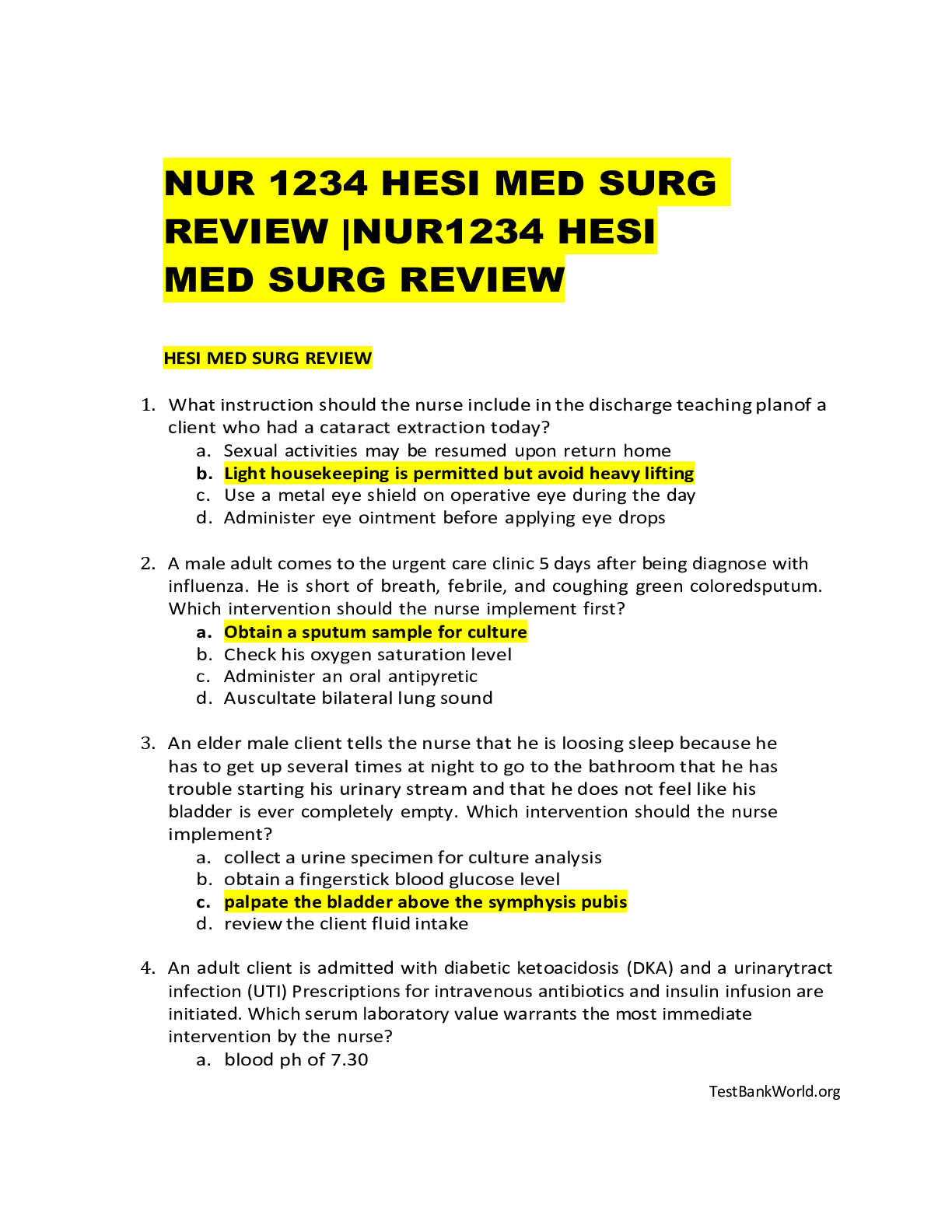

.png)

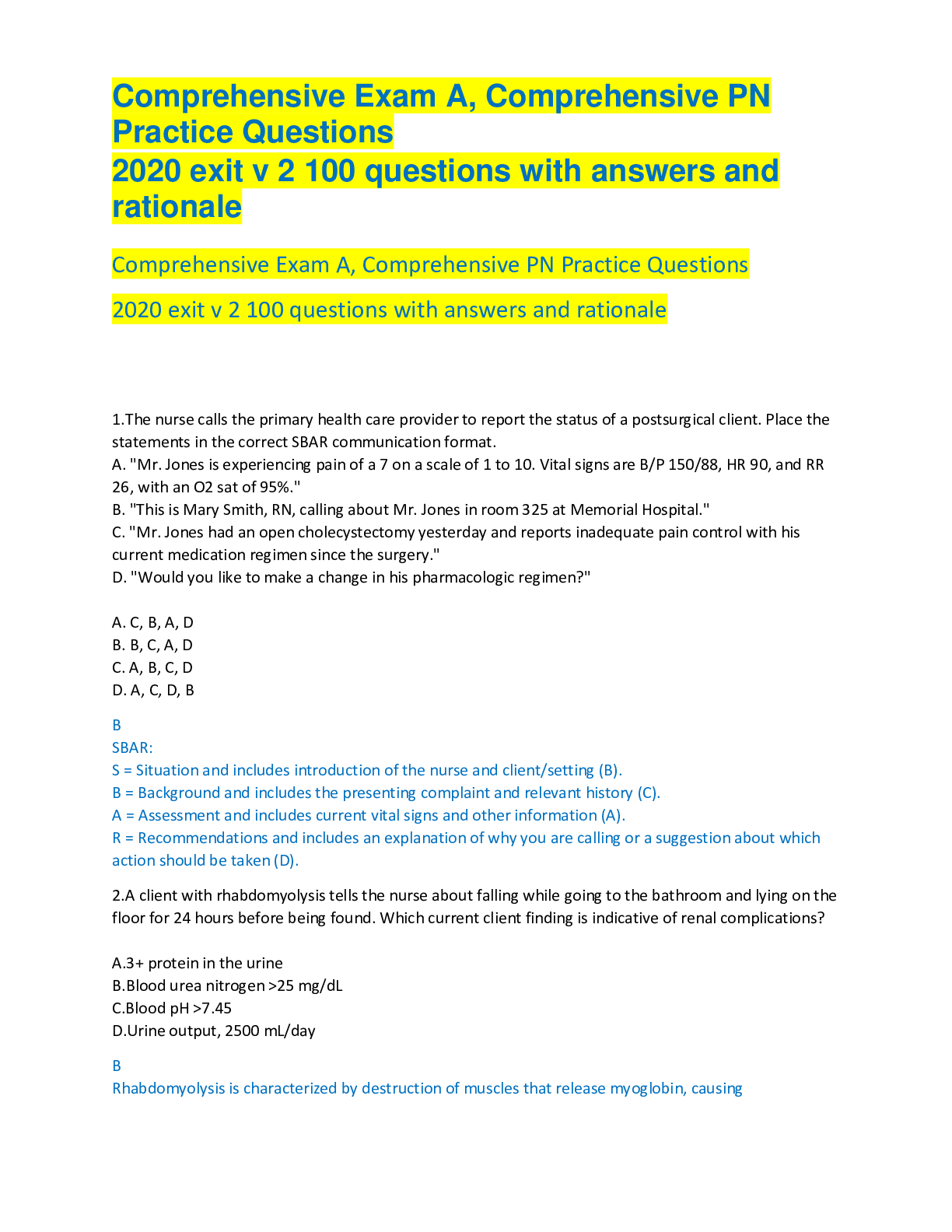
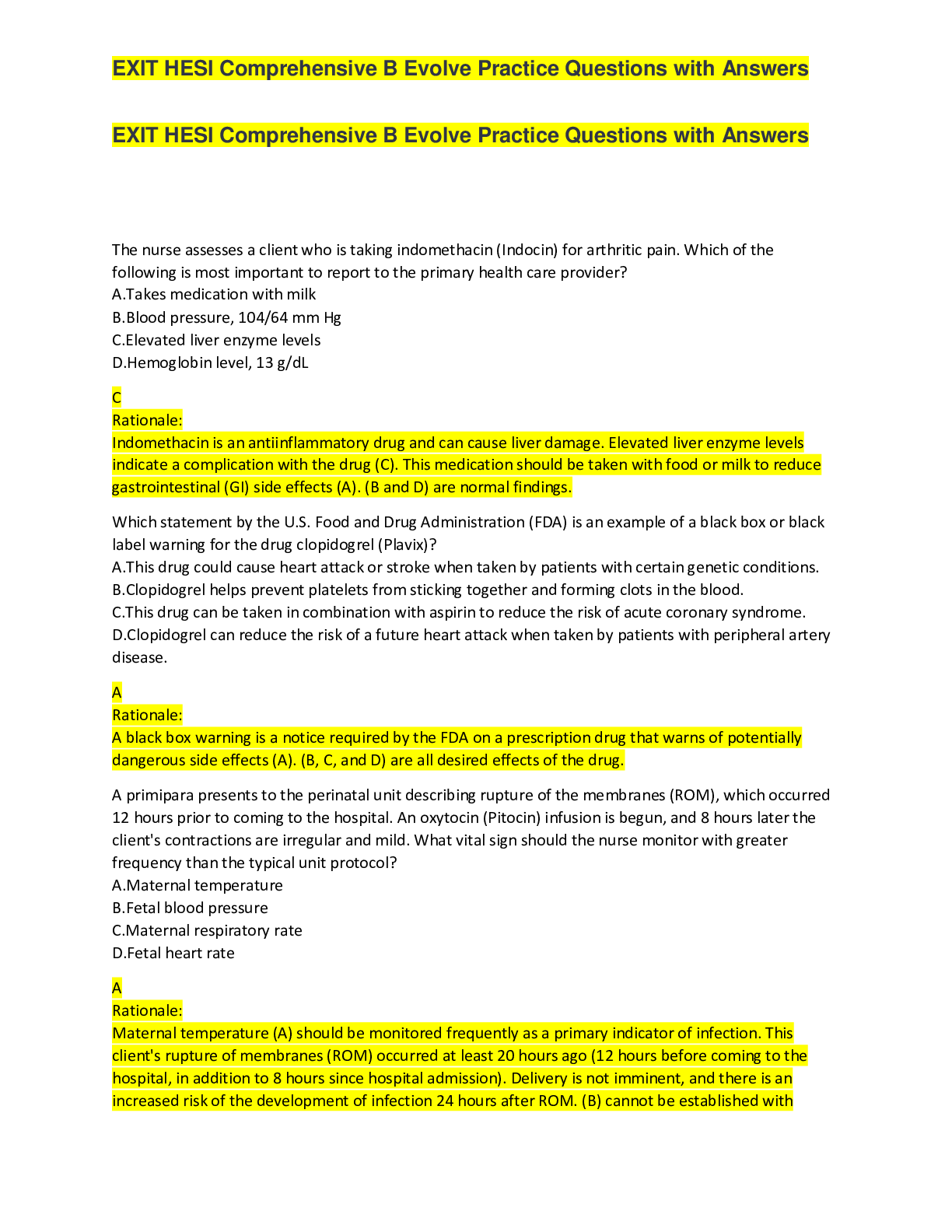



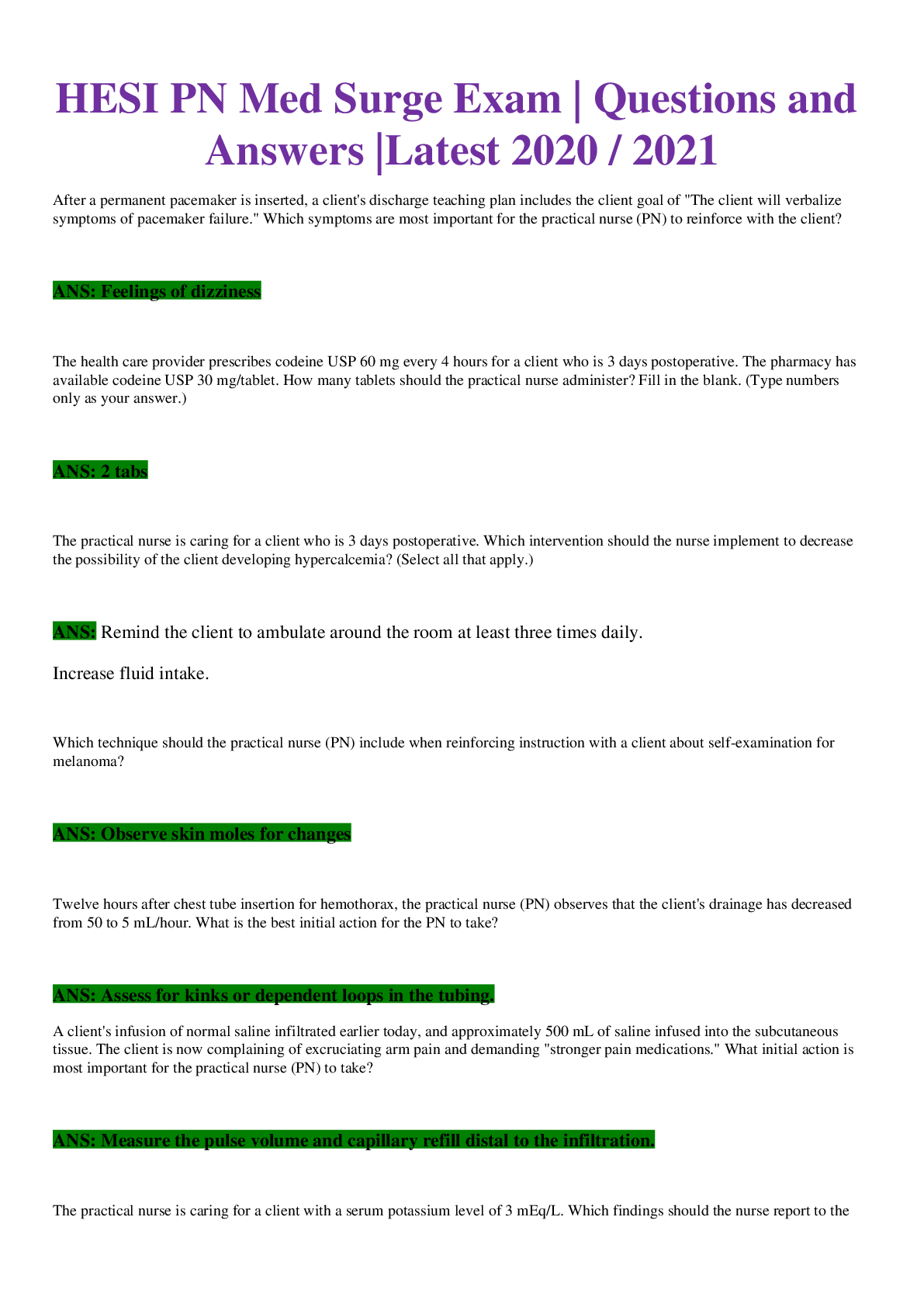

.png)

